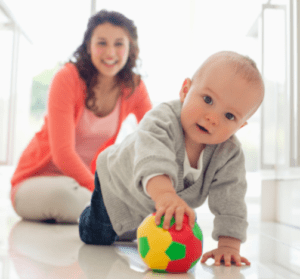Variety is the Hallmark of Typical Development
Let’s do an Experiment
Note what position your baby is in. Close your eyes for 30 seconds, and then open them. Is your child in the same position? Have they moved or shifted? Did you already know what position they would be in before you opened your eyes?  Variety in movement and positioning is the hallmark of typical development.
Variety in movement and positioning is the hallmark of typical development.
Babies, toddlers, and kids are wiggly creatures! They should constantly be moving, changing positions, playing with objects around them, and following their curiosity. If you watch a child over the course of a few minutes, you will see a range of different movements and postures.
Baby on the Move & Typical Development
Think about the movement and play skills of an 11-month-old. A baby this age will see a puzzle that she would like to play with on the couch across the room. She crawls up to the couch, pulls herself up to stand, and plays with the puzzle in standing. She accidentally drops a piece on the floor, so she squats down while holding the couch to retrieve it.
When she stands back up, she realizes that it’s fun to drop puzzle pieces on the floor. She throws the rest down, then transitions to sit on floor to play with the pieces. She notices her blocks nearby, and leans as far as she can to grab them, then returns to sit to bang a puzzle piece and a block together.
Think about all of the different movements and postures this baby utilized in only a few minutes! She transitioned from sit to crawling, crawled across the room, pulled herself to stand, squatted, sat down, leaned back and was slightly unbalanced, transitioned back to sitting…she never stopped! She was able to show off a wide variety of her skills just by playing with a puzzle. This variety is what pediatric physical therapists look for in development, at EVERY age!
“They Are Getting Into Everything!”
As a pediatric physical therapist, a favorite phrase to hear from parents is “they’re getting into everything!” This means that children are developing and utilizing motor skills in the way that they should be. Now try the “close your eyes for 30 seconds” test run again on your baby. Are you already peeking because it’s hard to leave them unsupervised for that long due to how much movement they have? Or do you know your child will stay in one position for long intervals until they are moved by you or repositioned? If it’s the latter, physical therapy can help get them moving and grooving, so that development feels fluid and natural for them. 
Questions about typical development our baby’s development? Give our movement experts a call at 773-687-9241 to schedule an evaluation to help your child on their way to exploring!


